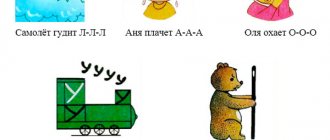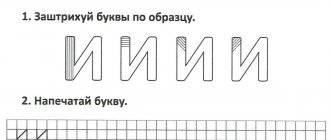Special symbols in preparing 4-year-old children for learning to read and write, Tkachenko T.A., 2000
Special symbols in preparing 4-year-old children for learning to read and write, T.A. Tkachenko, 2000. The manual by the famous Moscow speech therapist-practitioner, author of 10 books, presents theoretical principles and practical recommendations, as well as a system of training for 4-year-old children their skills of sound analysis and synthesis, without which mastering literacy is impossible. The use of original author's symbols makes it possible to most effectively prepare children with and without problems in speech development to master reading and writing. The manual contains entertaining games and exercises, as well as lesson notes that are recommended to be carried out with preschoolers in children's educational institutions and with their families. Addressed to teachers of mass and correctional groups, defectologists and speech therapists, students of pedagogical universities and colleges, as well as tutors and parents of preschool children. Introduction. The main task of any preschool institution is to prepare the child for school, including the acquisition of written language. One of the indicators of a child’s readiness to read and write is clean, clear, correct speech in all respects. At the age of 4, many children correctly pronounce all the sounds of their native language without the intervention of a speech therapist, and it would seem that there are no obstacles to their acquisition of literacy. At the same time, in the process of teaching such preschoolers to read and write, adults may encounter certain difficulties. Using this manual will help you overcome them, turn learning sound analysis into an interesting and at the same time effective game, and answer many theoretical and practical questions for teachers and parents. If a 4-year-old child has pronunciation defects or more complex speech disorders (dysarthria, rhinolalia, alalia, general speech underdevelopment), then the process of teaching literacy to such a preschooler is seriously complicated. Content. Introduction. Information that is useful to know for teachers and parents who are preparing to teach a preschooler to read and write. The role of symbols in preparing preschoolers for literacy. Planning and conducting classes to prepare for learning to read and write in mass groups of children's educational institutions. Conducting classes on the formation of the phonetic side of speech in speech therapy groups. Lesson notes. Bibliography. Application. Visual material (images of special characters).
Download the e-book for free in a convenient format, watch and read: - fileskachat.com, fast and free download.
Below you can buy this book at the best price with a discount with delivery throughout Russia. Buy this book
How to open a file
Copyright holders
- pdf - Yandex.Disk. - djvu - Yandex.Disk.
Publication date: 07/02/2019 09:07 UTC
Tkachenko :: 2000 :: child :: preparation :: literacy
See also textbooks, books and educational materials:
- Teaching literacy in kindergarten, Starzhinskaya N.S., 2000
- Preparation for teaching literacy to children 5-6 years old, scenarios of educational activities, Zhurova L.E., 2013
- Syllable structure of a word, Correction of violations, Speech therapy notebook, Tkachenko TA
- Education with sound, music lessons, Rokityanskaya T.A., 2005
The following textbooks and books:
- Preparing children for school, a manual for parents, Bolsun N.V., Revtovich N.M., 2007
- Educational moments, how to love a child, leave me to the children, Korczak Y., Stotskoy L., 2017
- Classes with children 2-3 years old, social development, the world around us, Vinnikova G.I.
- Preparing disabled children for family and adult life, a manual for parents and specialists, Yarskaya-Smirnova E.R., 2007
Previous articles:
- The main book about education, how great it is to be with children, Surkova L., 2018
- Children from heaven, parenting lessons, how to develop a spirit of cooperation, responsiveness and self-confidence in a child, Gray D., 2013
- Implementation of a systematic approach in youth education, monograph, Ananyin G.E., Bayborodova L.V., 2012
- Staging sounds.
<< Previous articleNext article >>
The number of children with speech pathology is growing every year, as evidenced by the results of examinations of children entering first grade. Of particular concern is the fact that among children with speech pathology, the number of children with general speech underdevelopment is steadily increasing. If systemic underdevelopment of speech is not eliminated in time, as a rule, it leads to difficulties in mastering the skills of writing and reading, and their further development into dysgraphia and dyslexia. This can lead to persistent failure in the Russian language, literary reading and other subjects of the school curriculum, a gradual decline in motivation to learn, and, as a consequence, to school maladjustment.
Based on this, the main goal of speech therapy classes with primary schoolchildren is to prevent and overcome speech disorders that impede the successful learning of children. The school speech therapist is faced with the task of eliminating gaps in the child’s speech development as efficiently as possible and in the shortest possible time.
A.V. Yastrebova noted that it is necessary to find “an approach to planning and conducting correctional education that would contribute to the maximum extent to the elimination of speech defects and the overall development of children with minimal time investment. This is necessary in order to both prevent possible secondary consequences of the defect and the increase in pedagogical neglect.”
In correctional and speech therapy work with first-graders, the main emphasis is on timely and targeted preparation of them for learning to read and write. However, the immaturity of cognitive, regulatory and communication skills characteristic of many primary schoolchildren with special needs development significantly complicates the achievement of this goal. This necessitates the construction of correctional and developmental education based on the formation and development in children of full-fledged universal educational actions that allow teaching a child to learn.
A special group among general educational universal actions consists of sign-symbolic actions . The use of sign-symbolic means increases the effectiveness of speech therapy classes and allows you to present information taking into account all forms of perception. “The more sense organs take part in the perception of objects, the more impressions the child receives, the more firmly they are stored in his consciousness and then easier to remember” (K.D. Ushinsky). Involving visual support in the form of a system of signs and symbols helps to use all channels of perception, activate speech-mental activity towards linguistic phenomena, activate vocabulary and develop children, develop operations of analysis, synthesis, comparison, generalization, self-control, and increase children’s motivation for speech therapy classes. The use of sign-symbolic means not only helps to overcome speech disorders, but also helps to attract children's attention, memory and ability to switch (A.V. Yastrebova).
The introduction of visual models is possible at all stages of speech therapy work and is effective both in the process of preventing written speech disorders (dysgraphia, dyslexia, dysorthography) and their correction.
When introducing sign-symbolic means, it is necessary to take into account that according to the theory of the formation of mental actions developed by P. Ya. Galperin, every mental action goes through certain stages of formation:
a) relying on auxiliary means;
b) in terms of speech, excluding visual supports, only pronunciation;
c) internally.
Types of sign-symbolic activities:
- Substitution.
- Coding.
- Schematization.
- Modeling.
- Substitution is the reproduction of reality by replacing real objects or subjects with objects of different meanings.
- Coding (decoding) is the translation of reality into a sign-symbolic language and the subsequent decoding of information. Any substituents can be used in coding.
3. Schematization - orientation in reality (structuring, identifying connections), carried out simultaneously in two plans with a constant element-by-element correlation of the symbolic and real plane. In schematization, diagrams act as substitutes. 4. Modeling - transformation of an object from a sensory form into a model, where the essential characteristics of the object are highlighted (spatial-graphic or iconic-symbolic).
Let us consider the features of the use of sign-symbolic means at the first stage of correctional activity, which consists of filling gaps in the development of the sound side of speech (sound pronunciation and the formation of full-fledged ideas about the sound composition of a word).
Sign-symbolic means are used in all directions of correction of the sound aspect of speech
- when staging, automating, differentiating sounds;
- during the formation of phonemic processes;
- when clarifying initial ideas about the sound-letter, syllabic composition of a word;
- when introducing words-terms: sound, syllable, merger, word, vowels, consonants, hard-soft consonants, voiced-voiceless consonants, sentence, etc.
The use of sign-symbolic means in the process of staging, automation, and differentiation of sounds.
Teachers and speech therapists use various types of sound models, which, through certain symbolism, make it possible to highlight and consolidate the idea of the essential characteristics of sounds.
At the initial stage sound production , the verbal description of articulation is based on a graphic diagram using signs - symbols that characterize the main points of articulation (position of the tongue, lips, teeth, the work of the vocal cords, the strength and nature of the exhaled air stream).
For example:
In the process of producing and automating sounds, relying on a graphical diagram allows you to effectively help your child:
- articulate sounds correctly;
- teach techniques for verbalizing your actions when mastering articulatory patterns;
— promotes the development of self-control skills in the process of sound production and automation;
The process of differentiating mixed phonemes is greatly facilitated with the use of sign-symbolic means. Based on the patterns of sound articulation compiled with the active participation of children and the sound articulation models they have mastered, general and differential features of phonemes (articulatory and acoustic) are identified.
For example:
Gradually, images become less and less similar to real objects, more schematic and abstract, and are replaced by icons - symbols. The image of the lips in a smiling position is replaced by an arc, the position of the lips in the form of a tube is replaced by a circle. Children learn to operate with these symbols by performing various types of tasks based on them, for example:
1).Listen to the sounds that I will pronounce and encrypt them in your notebook using icons;
2). Listen to the sounds I will make and show the symbol card;
3). “Decipher” the sounds “encrypted” by the icons.
4). Place the picture in the mailbox (distribute the pictures according to the presence of sounds [c] or [w] based on the drawn sound symbols).
After the differentiation of oppositional sounds based on symbols - substitutes and in the speech plane, work is carried out only in the internal plane. The work on differentiation of other mixed phonemes is constructed in a similar way. Systematic application of these working techniques will help prevent writing errors caused by acoustic-articulatory dysgraphia.
The use of sign-symbolic means in the formation of phonemic processes and in clarifying initial ideas about the sound-letter, syllabic composition of a word.
“sound”, “syllable”, “word”, which are difficult for children with speech pathology to understand (L.A. Venger, O.M. Dyachenko and etc.) , since, as is known, they assimilate visual material better than verbal material.
Visual symbols of sounds (signs)
Many first-graders with OHP do not pronounce even vowel sounds clearly enough and have little sense of articulatory movements. This makes it difficult to develop phonemic processes and language synthesis analysis skills. In this case, it is advisable to use visual symbols of sounds (signs) developed by T.A. Tkachenko. These symbols are useful in identifying characteristic features of the pronunciation of vowels and help prevent the frequent substitution of vowels in children with dysgraphics.
Initially, it is advisable to use vowels with contrasting changes in articulatory patterns. Regular use of these exercises will help consolidate the sensory and kinesthetic image of sounds (not only vowels, but also consonants), and will draw children’s attention to changes in their articulatory patterns.
Planar and volumetric models of sounds.
The use of visual supports-symbols makes it possible to prepare children for mastering sound analysis: it consolidates the idea of speech sounds and the ability to carry out sequential (successive) analysis of the sound composition of a word, differentiate vowels/consonants: hard/soft, voiceless/voiced consonants, stressed and unstressed vowels . Planar and volumetric sound models are used as sound substitutes auxiliary means: red squares or circles; to indicate consonant sounds - blue and green squares (hard/soft) with or without bells (voiced/voiceless).
However, it should be noted that at the beginning of training it is more convenient to use a three-dimensional model than a planar one. As a three-dimensional sound model, you can use plastic caps or wooden (plastic) cubes of the appropriate color. It is convenient to manipulate, move, and rearrange three-dimensional sound models, achieving the correctness of the laid out word pattern, completing the tasks of the speech therapist teacher:
- name each sound, touching each cap in turn;
- name and show the caps that indicate vowel (consonant) sounds;
- how many sounds are there in a word?; how many vowels?; how many consonants?
- name the hard (soft) consonant sounds in the word;
- divide the word into syllables; how many syllables are there in a word? Why? remember the rule;
- highlight fusion syllables;
- transform the word by adding (subtracting) only one sound so that you get a new word (ball - balls, ball - balls, mole - mouth; wolf-ox, etc.).
Working with planar and three-dimensional sound models helps students more easily recreate linear sequences of sounds and syllable structures. Models - sound substitutes serve as visual and tactile support for the sound analysis of a word. Having started with the analysis of syllables, the child gradually begins to cope with the analysis of words that are quite complex in sound and syllabic composition. Regular and repeated use of the technique will allow you to transfer the operation of sound analysis and synthesis from the external to the internal plane and thereby prevent omissions and rearrangements of letters in writing. This type of work is especially effective in preventing and correcting dysgraphia caused by impaired language analysis and synthesis.
The use of sign-symbolic means “sound”, “vowels and consonants”.
Many children with OHP have difficulty mastering such abstract concepts as “sound”, “vowels and consonants”. Difficulties begin with mastering the very concept of “sound”. Often the rather abstract concept of “sound” is replaced by the more concrete, understandable and visible “letter”. Using the technique of schematization makes it possible to facilitate this task, making the assimilation of these concepts more accessible and durable.
Thus, the distinctive features of these sounds (the presence or absence of an obstruction in the exhaled air) are more visual, tangible and less abstract. Based on observations of the work of the organs of articulation and with a constant element-by-element correlation of the symbolic and real plane, children draw up the following diagrams under the guidance of a speech therapist teacher:
1. 2.
The use of schemes, thanks to the reliance on the visual channel of perception, makes the process of mastering such concepts as “vowels” and “consonants”, which are difficult for children with special needs, faster and more durable.
Manual and graphical sound models
The assimilation of the concepts of “vowels and consonants” becomes even stronger with the involvement of kinesthetic sensations and the use of manual and graphic models of sounds . Both types of models are based on such a feature of vowels and consonants as the degree of opening of the mouth at the moment of passage of the air stream during sound articulation. Signs and symbols used: vowel sounds are designated as a circle (which correlates with the feature of vowels as “mouth openers”); consonant sounds are a feature (participation of the speech organs as “mouth openers”). The active participation of children in the “creation” of models will enhance the effect of using the technique.
1.Manual models of vowels and consonants
Manual vowel model Manual consonant model
2. Graphic models of vowels and consonants
— Graphic model of the vowel sound O
— Graphic model of consonant _ sound
The procedure for working with manual and graphical models can be as follows:
- Identification by children, under the guidance of a speech therapist, of the articulation features of vowels and consonants, based on visual and tactile control and correlation with a suitable symbol model.
- "Dictation" of sounds. Students "scramble" perceived vowel or consonant sounds using a manual (graphic) model.
- Coding a word in the process of sequential sound analysis of a word based on a manual (graphic) model; For example, the words “juice” and “cabbage” are encrypted as follows:
− ⃝ −, “cabbage” − ⃝ − ⃝ − − ..⃝.
4. Recording a word without relying on a manual model (coding occurs internally).
5. Deciphering (voicing) the word model.
The use of exercises in which various types of symbolism, encryption, modeling of words using a manual model and signs-symbols are used will contribute to the development of successive functions and sound analysis skills.
Based on the signs-symbols of sounds, sound analysis schemes .
With the introduction of sign-symbolic modeling of the sound composition of a word, an algorithm for sound-letter analysis of the word is developed.
Acting initially according to an algorithm and relying on auxiliary means, children subsequently independently perform sound-letter analysis of words, planning actions and performing them in terms of internal speech.
Gradually, the use of verbal instructions, kinesthetic and auditory control becomes leading and is carried out without material support.
Thus, the use of signs-symbols allows children with speech pathology to effectively and with minimal time and effort not only streamline their ideas about the sound side of speech, master the skills of analysis and synthesis of the sound-letter composition of a word, helps to visually represent abstract concepts (sound, word, sentence, text), learn not only to work with them;
but also
— increases motivation for learning, develops interest in linguistic phenomena and communication;
— improves the child’s speech-thinking activity, promotes mastery of the operations of analysis and synthesis and the gradual transformation of children’s visual-figurative thinking into verbal-logical thinking;
— activates the work of the visual, auditory, kinesthetic analyzers;
– promotes the development of visual, motor, associative memory
This creates the necessary prerequisites for the formation and consolidation of the skills of correct writing and reading, and the formation of universal educational activities.
Bibliography:
- Wenger L.A. Is your child ready for school? – M.: Knowledge, 1994.
- Goretsky V.G. ABC, 1st grade, at 2 o'clock, - M., Prosveshchenie, 2012.
- Misarenko G.G. Teaching phonemic analysis in 1st grade: Methodological manual. - M.: Sfera TC, 2008. - 120 p.
- Sadovnikova I.N. Disorders of written speech and their overcoming in primary schoolchildren. – M.: “Gits Vlados”, 1997.
- Yastrebova A.V. Bessonova T.P. Instructional and methodological letter about the work of a speech therapist at a secondary school. (Main directions of formation of prerequisites for productive mastery of the native language teaching program for children with speech pathology). - M.: "Cogito-Center", 1996 - 47 p.





